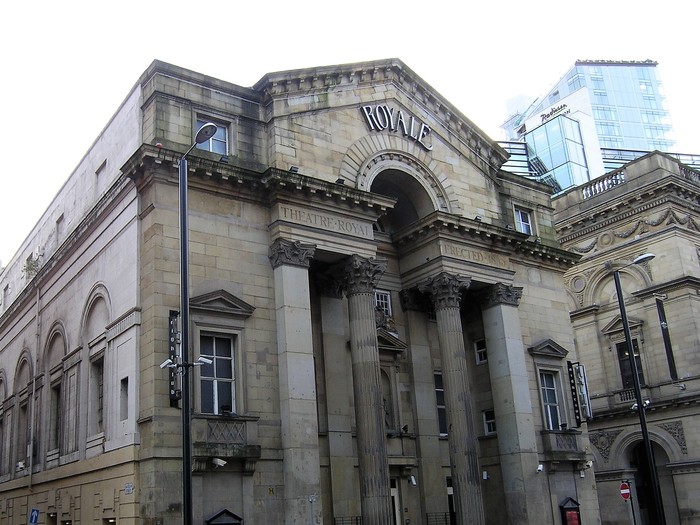Theatre Royal
Built in 1845, this is Manchester's oldest surviving theatre building and one of the finest examples of theatre architecture to have survived in Britain from the first half of the nineteenth century.

- Address
- Peter Street, Manchester, M2 3NQ
- Risk Rating
- 4 (Community Value: 1, Star Rating: 2, Risk Factor: 1)
- Local Authority
- Manchester City Council
- Architect
- John Gould Irwin & Francis Chester
- Date of Construction
- 1845
- Listing
- Grade II
- Capacity
- 1,000 (estimated)
- Database Link
- View in Theatres Database
Significance
The Grade II listed, Theatre Royal is Manchester's oldest surviving theatre building. It was built in 1845, and is an impressive building in the Classical style, its monumental façade considered one of the finest examples of theatre architecture to have survived in Britain from the first half of the nineteenth century. It was a source of inspiration for Richardson and his partners when designing the front of London’s Royal Opera House. Internally, the ceiling, although now not easily visible, has deeply coved sides and basketwork enrichment also reminiscent of the Royal Opera House.
The theatre was internally remodelled in 1875 and again in 1921 but has retained its ornate plasterwork. Its stage machinery is also understood to have survived. The conversion of the building to nightclub use obscured rather than destroyed the theatre interior and it could be restored. More research is needed to fully understand its architectural and historical significance.
Why is this theatre at risk?
Theatre Royal Manchester has been on the Theatres at Risk Register since 2013.
The theatre was used as a nightclub, but this closed in 2009. There was a possibility that the former Library Theatre might relocate into the Theatre Royal, but this was superseded by the creation of HOME Manchester.
In 2012, the building was bought by hotel developer Edwardian Hotels London for redevelopment. It has yet to release its proposals for the building and, had been using it as ancillary accommodation including as a workshop and store. While neither are the optimum use for the building, at least this has meant that the hotel group is aware of any urgent maintenance issues.
A visit to the building by Theatres Trust and the planning case officer at Manchester City Council in 2019 noted that the hotel-developer had carried out some minor works to the building without listed building consent. The council has since reminded the hotel of its obligations as an owner of a listed building, including the requirement to submit listed building consent and also provided it with some advice on roof repairs. Theatres Trust requested that protection to the fragile historic plaster finishes also be provided and that a management policy be put in place to ensure that those working within the theatre building are made aware of the building’s listed status and areas of historic significance and fragility.
In 2024, Theatres Trust was alerted to potential issues with water ingress and has contacted the council about these concerns. It is understood that the council is speaking with the owner and will be undertaking an inspection of the building the building is secure and watertight.
Theatre potential
Despite the theatre being within a city that already has a good and broad cultural and theatrical offer, the building is in a central location, in relatively good condition and could be returned to live performance use.
Since the building’s inclusion on the Register there has been interest in restoring and reopening it for live performance use, however, current ownership remains a barrier.
Current situation
Theatres Trust has been contacted by several different organisations all with a potential interest in acquiring the building and reopening it for entertainment use. This could see a vibrant and sympathetic new use for the theatre.
Theatres Trust will continue to seek a route to open discussions with Edwardian Hotels London and / or a future owner to ensure that any proposals for the Theatre Royal will preserve the significance of this important building and not preclude it from being brought back into live performance use in the future.
Main photo Theatre Royal, Ian Grundy